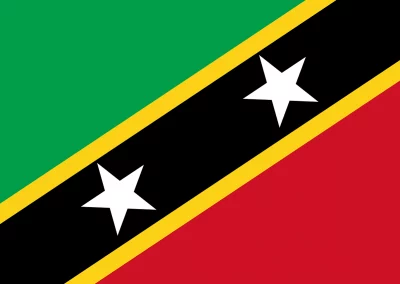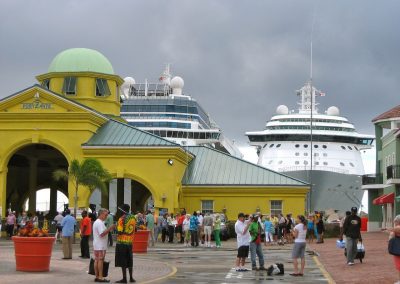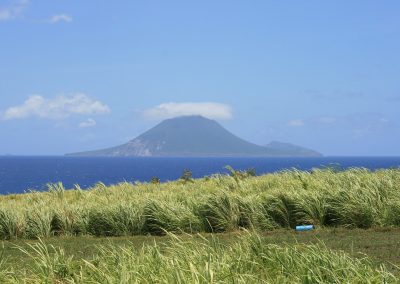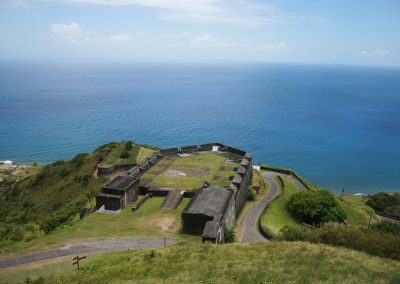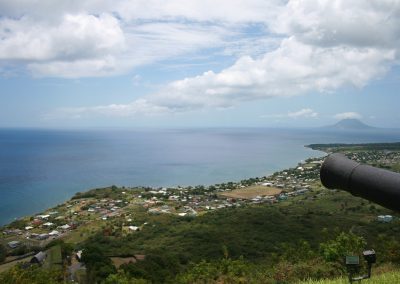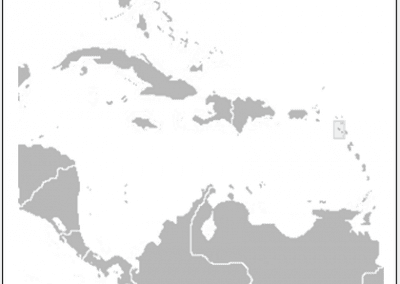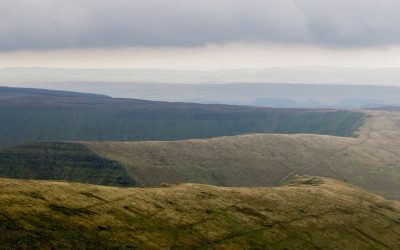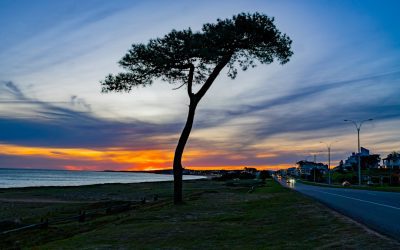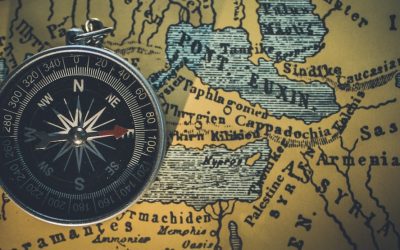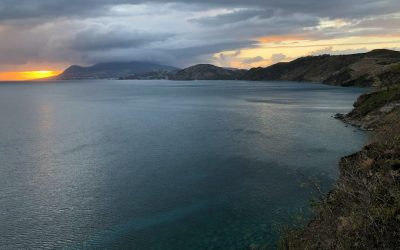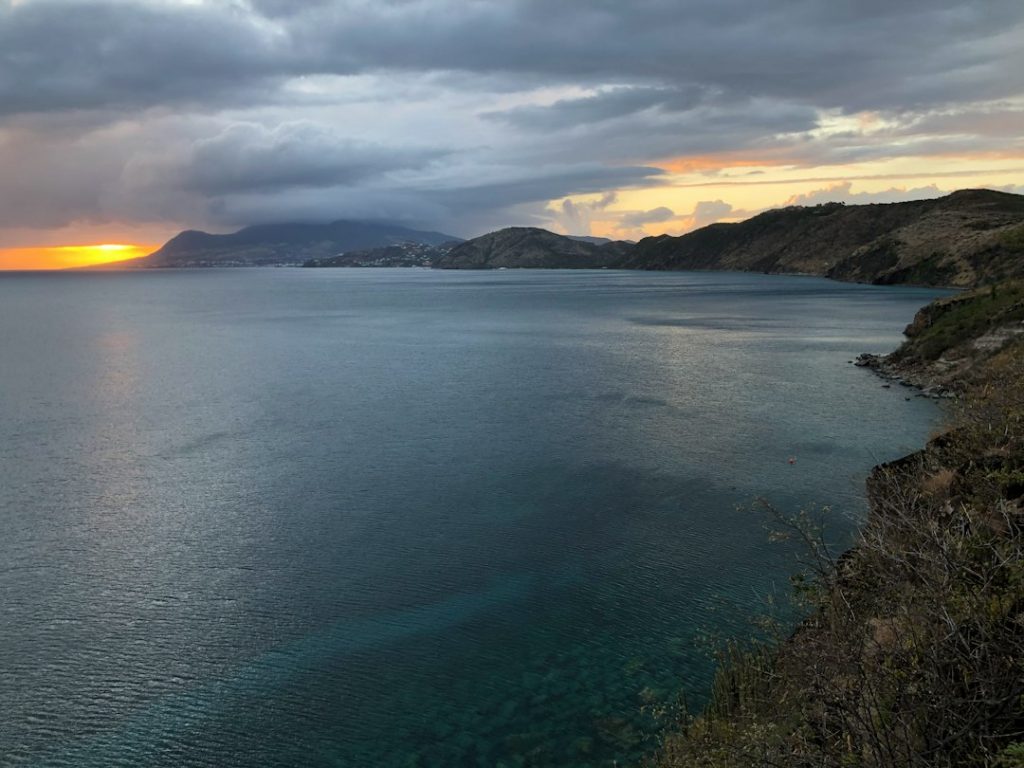Saint Kitts and Nevis
(Federation of Saint Kitts and Nevis)
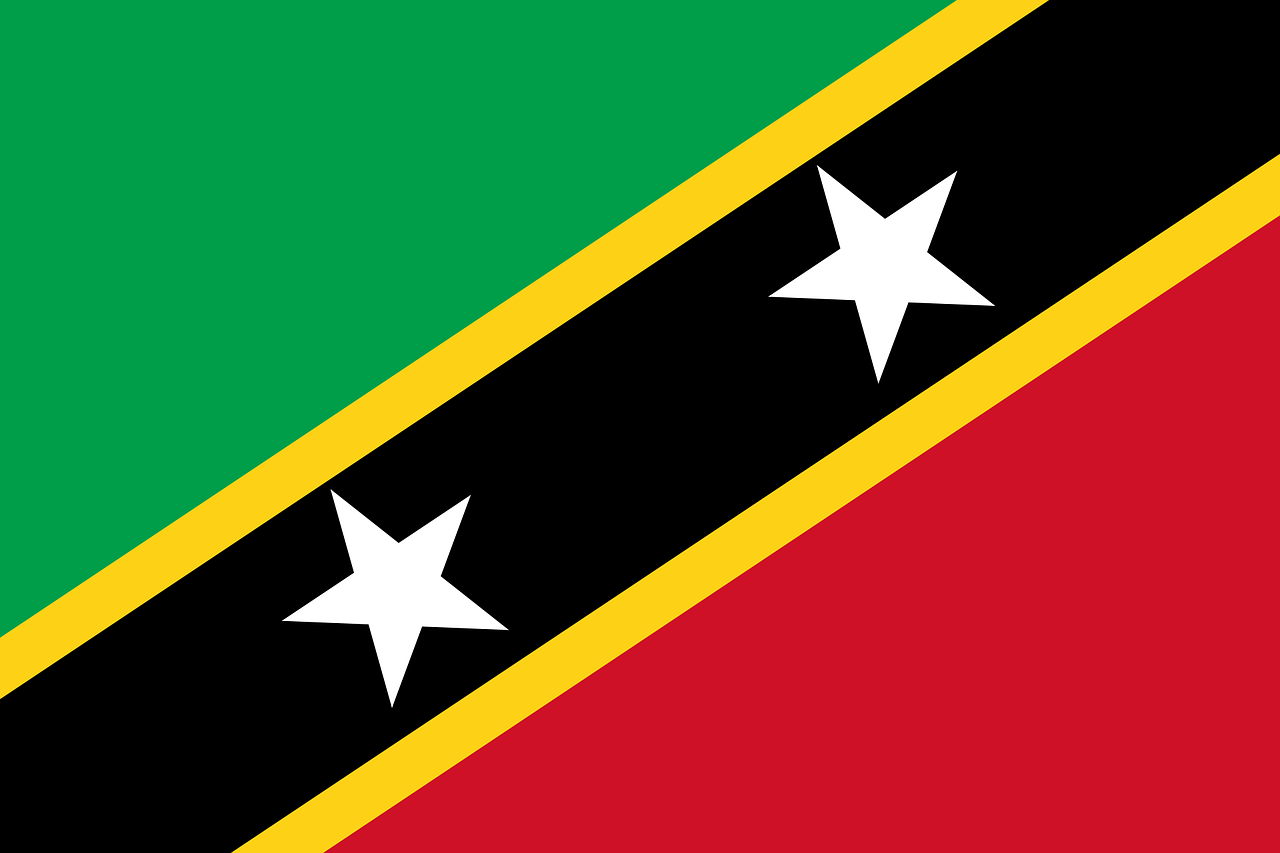
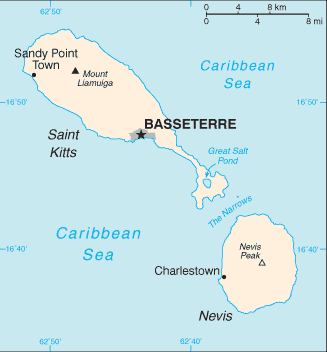

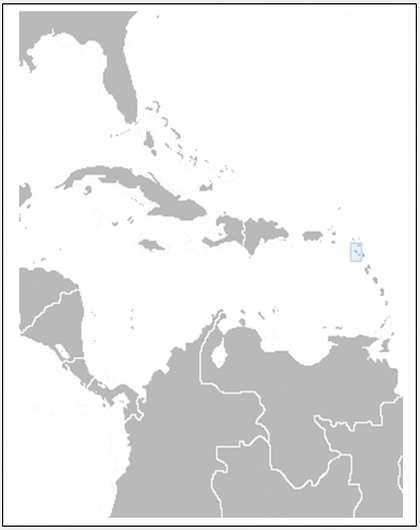

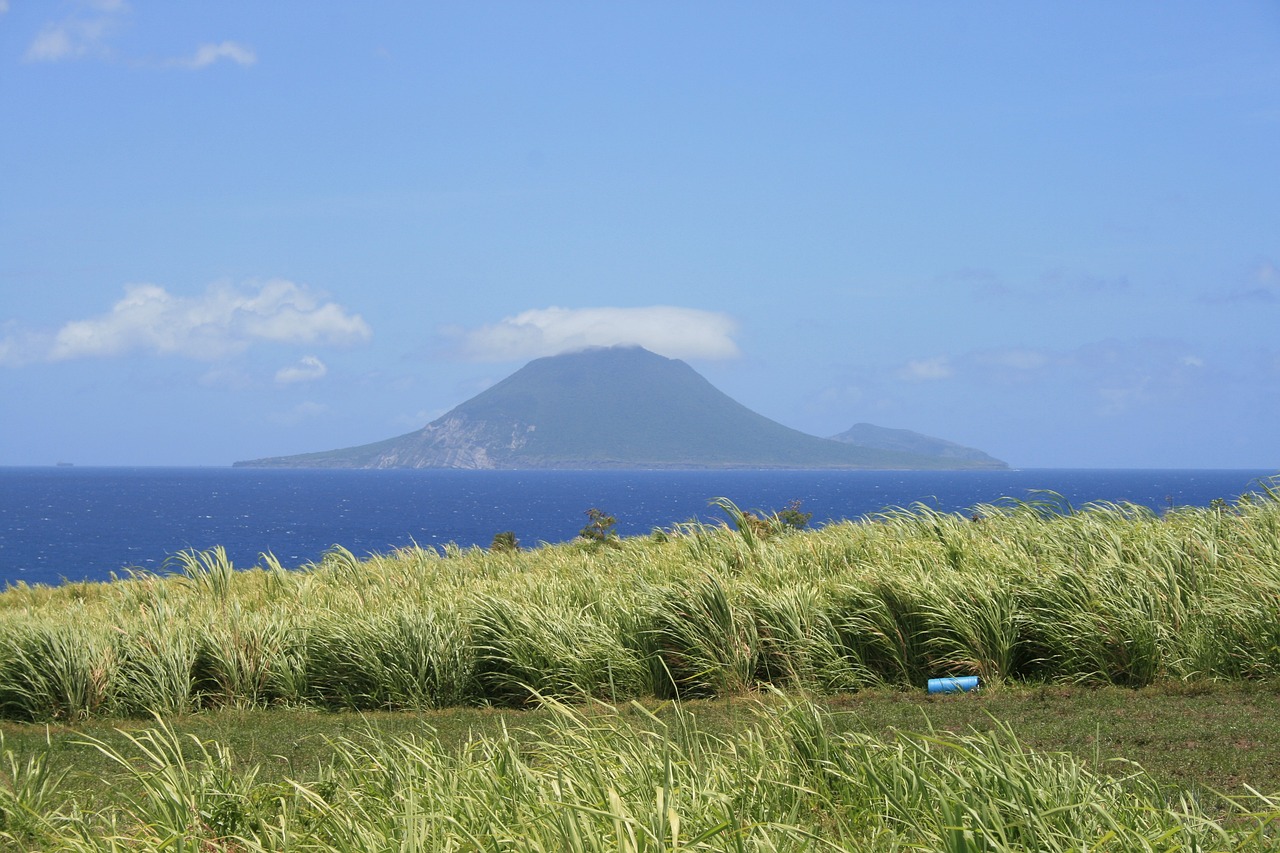
Capital: Basseterre
Population (Estimated July 2012): 50,726
Area: 269km2 or 104mi2
Currency: Eastern Caribbean Dollar (EC$)
Official Language: English
Political Information: Constitutional Monarchy with a democratic Parliament
Official Religion: No Official Religion
(mainly Anglican, other Protestant, Roman Catholic)
Highest Mountain: Mount Liamuiga at 1,156m or 3,793ft
GDP Official Exchange Rate (OER is more precise at gauging a country’s economic power)
(Estimated 2011): $700 million (US$) or (GBP)
GDP (OER) Per Capita (per member of the population estimated 2011): (US$) or (GBP)
GDP Purchasing Power Parity (PPP is good for gauging living conditions and use of resources but is not as accurate as OER. This data has been calculated based on the sum value of all goods and services produced in the country valued at prices prevailing in the United States)
(Estimated 2011): $918 million (US$) or (GBP)
GDP (PPP) Per Capita (per member of the population estimated in 2011): $700 million (US$) or (GBP)
Time Zone (GMT/UTC): -4:00
Wildlife:
Counties/Provinces/States: 14 parishes; Christ Church Nichola Town, Saint Anne Sandy Point, Saint George Basseterre, Saint George Gingerland, Saint James Windward, Saint John Capesterre, Saint John Figtree, Saint Mary Cayon, Saint Paul Capesterre, Saint Paul Charlestown, Saint Peter Basseterre, Saint Thomas Lowland, Saint Thomas Middle Island, Trinity Palmetto Point
Leaders: H.M. Queen Elizabeth II, represented by Governor-General Sir Cuthbert Sebastian and Prime Minister Denzil Douglas
Sources: CIA World Fact Book, Encyclopaedia Britannica.
Saint Kitts and Nevis
Saint Kitts and Nevis, a twin-island nation nestled in the Caribbean Sea, is a gem that often escapes the attention of many travellers. This enchanting destination, known for its lush landscapes and vibrant culture, is the smallest country in the Western Hemisphere, both in terms of area and population. The islands are characterised by their stunning beaches, verdant mountains, and a rich tapestry of history that reflects a blend of indigenous, colonial, and African influences.
Visitors to Saint Kitts and Nevis are often captivated by the warm hospitality of its people, the rhythmic pulse of calypso music, and the tantalising flavours of local cuisine, all of which contribute to an unforgettable experience. The allure of Saint Kitts and Nevis extends beyond its natural beauty; it is a place where history and modernity coexist harmoniously. The islands boast a unique charm that draws in those seeking both relaxation and adventure.
From the bustling capital of Basseterre on Saint Kitts to the serene beaches of Nevis, each corner of this nation offers something distinct. As global interest in sustainable tourism grows, Saint Kitts and Nevis stands poised to showcase its commitment to preserving its natural environment while providing visitors with an authentic Caribbean experience. This article delves into the rich history, geography, culture, economy, and natural attractions of Saint Kitts and Nevis, painting a comprehensive picture of this remarkable nation.
Summary
- Saint Kitts and Nevis is a small island nation located in the Caribbean, known for its beautiful beaches and rich history.
- The islands were first inhabited by the Arawak and Carib people, and later colonized by the British and French, before gaining independence in 1983.
- Saint Kitts and Nevis has a tropical climate with warm temperatures year-round, making it an ideal destination for beach lovers and outdoor enthusiasts.
- The culture of Saint Kitts and Nevis is a blend of African, British, and French influences, with vibrant music, dance, and festivals celebrated throughout the year.
- The economy of Saint Kitts and Nevis relies heavily on tourism, with the islands offering a range of attractions including historic sites, natural beauty, and diverse wildlife.
History of Saint Kitts and Nevis
Indigenous Peoples and Early European Exploration
The history of Saint Kitts and Nevis is a complex narrative that begins long before European colonisation. The islands were originally inhabited by the Arawak and Carib peoples, who thrived on the abundant resources provided by the land and sea. However, the arrival of European explorers in the late 15th century marked a significant turning point in the islands’ history. Christopher Columbus is often credited with discovering Saint Kitts in 1493, although it was not until 1623 that the first permanent settlement was established by the British. This early colonisation led to fierce conflicts with the indigenous populations, resulting in a dramatic decline in their numbers and influence.
Colonialism and the Sugar Industry
As the British and French vied for control over these strategic islands, Saint Kitts and Nevis became a focal point for sugar production in the Caribbean. The introduction of enslaved Africans to work on sugar plantations transformed the demographic landscape and laid the foundation for the islands’ economy for centuries to come. The legacy of colonialism is still palpable today, as it has shaped not only the social structure but also the cultural identity of the nation.
Independence and Cultural Heritage
Following a long struggle for independence, Saint Kitts and Nevis finally gained its sovereignty from Britain in 1983, becoming a fully independent nation while maintaining ties to the Commonwealth. This historical journey has imbued the islands with a rich cultural heritage that continues to influence their identity.
A Lasting Legacy
The complex history of Saint Kitts and Nevis has left an indelible mark on the nation, shaping its social structure, cultural identity, and economy. As the islands continue to evolve, they remain deeply connected to their past, with a rich cultural heritage that continues to inspire and influence their people.
Geography and Climate of Saint Kitts and Nevis
Saint Kitts and Nevis is characterised by its stunning geographical features, which include volcanic mountains, lush rainforests, and pristine beaches. Saint Kitts, the larger of the two islands, is dominated by the imposing Mount Liamuiga, an extinct volcano that rises to 1,156 metres above sea level. The island’s diverse topography offers a variety of ecosystems, from coastal mangroves to mountainous terrain, making it a haven for nature enthusiasts.
In contrast, Nevis is known for its more tranquil atmosphere and is often referred to as “Queen of the Caribees.” The island’s landscape is equally captivating, with Nevis Peak standing at 1,100 metres and providing breathtaking views of the surrounding waters. The climate in Saint Kitts and Nevis is classified as tropical, characterised by warm temperatures year-round and distinct wet and dry seasons. The dry season typically runs from December to April, attracting tourists seeking sun-soaked holidays during this period.
Conversely, the wet season spans from May to November, bringing occasional heavy rainfall but also contributing to the lush greenery that defines the islands’ landscapes. This climate not only supports diverse flora and fauna but also plays a crucial role in shaping local agriculture, particularly in the cultivation of sugarcane, fruits, and vegetables. The interplay between geography and climate creates an environment that is both beautiful and bountiful, making Saint Kitts and Nevis a unique destination for visitors.
Culture and Traditions of Saint Kitts and Nevis
The culture of Saint Kitts and Nevis is a vibrant tapestry woven from various influences that reflect its historical journey. The islands are renowned for their lively music scene, particularly calypso and soca genres that resonate during festivals and celebrations. Carnival is one of the most significant cultural events on both islands, showcasing colourful parades, energetic dancing, and infectious rhythms that bring communities together.
This annual celebration not only serves as a platform for artistic expression but also reinforces a sense of identity among locals who take immense pride in their heritage. Cuisine in Saint Kitts and Nevis is another vital aspect of its culture, with dishes that highlight local ingredients such as fresh seafood, tropical fruits, and spices. Traditional meals often feature staples like rice and peas or plantains alongside grilled fish or stewed meats.
Festivals dedicated to food also play an essential role in community life, where locals gather to celebrate their culinary traditions through cooking competitions and tastings. The fusion of African, European, and indigenous flavours creates a unique gastronomic experience that reflects the islands’ diverse history. Through music, dance, food, and festivals, the culture of Saint Kitts and Nevis continues to thrive, offering visitors an authentic glimpse into the heart of Caribbean life.
Economy and Tourism in Saint Kitts and Nevis
The economy of Saint Kitts and Nevis has undergone significant transformation over the years, evolving from its historical reliance on sugar production to a more diversified economic model. While agriculture remains important, tourism has emerged as a key driver of economic growth. The islands attract visitors from around the globe who seek sun-drenched beaches, luxurious resorts, and rich cultural experiences.
The government has invested heavily in developing infrastructure to support this burgeoning industry, including improved transportation links and enhanced hospitality services. Tourism not only contributes significantly to GDP but also provides employment opportunities for many locals. The government has implemented various initiatives aimed at promoting sustainable tourism practices that protect the environment while ensuring economic benefits for residents.
Eco-tourism ventures have gained popularity as visitors increasingly seek authentic experiences that connect them with nature. Activities such as hiking through rainforests or exploring marine parks allow tourists to appreciate the natural beauty of Saint Kitts and Nevis while supporting conservation efforts. As tourism continues to flourish, it plays a pivotal role in shaping the future economic landscape of this idyllic Caribbean nation.
Wildlife and Natural Attractions in Saint Kitts and Nevis
Exploring the Natural Beauty of Saint Kitts and Nevis
Saint Kitts and Nevis is home to an array of wildlife and natural attractions that captivate nature lovers and adventure seekers alike. The islands boast several protected areas where endemic species thrive amidst lush vegetation. For instance, the Central Forest Reserve on Saint Kitts offers hiking trails through dense rainforest teeming with diverse flora and fauna.
Wildlife and Conservation Efforts
Birdwatchers will delight in spotting native species such as the endemic St Kitts hummingbird or various migratory birds that visit during certain seasons. The rich biodiversity found within these protected areas underscores the importance of conservation efforts aimed at preserving these unique ecosystems. In addition to terrestrial wildlife, the surrounding waters are equally rich in marine life.
Discovering Marine Life and Natural Attractions
Snorkelling and diving enthusiasts flock to sites like Turtle Beach or Pinney’s Beach on Nevis to explore vibrant coral reefs teeming with colourful fish species. The islands’ commitment to marine conservation has led to initiatives aimed at protecting these delicate ecosystems while promoting sustainable fishing practices among local communities. Natural attractions such as Brimstone Hill Fortress National Park—a UNESCO World Heritage Site—offer visitors a glimpse into both history and breathtaking views over the Caribbean Sea.
A Paradise for Nature Lovers
With its stunning landscapes and diverse wildlife, Saint Kitts and Nevis presents an unparalleled opportunity for exploration and appreciation of nature’s wonders.
The Future of Saint Kitts and Nevis
As Saint Kitts and Nevis navigates its path forward into an increasingly globalised world, it faces both challenges and opportunities that will shape its future trajectory. The islands’ commitment to sustainable development will be crucial in balancing economic growth with environmental preservation. By prioritising eco-friendly tourism practices and investing in renewable energy sources, Saint Kitts and Nevis can position itself as a leader in sustainable tourism within the Caribbean region.
This approach not only benefits local communities but also enhances the overall visitor experience by preserving the natural beauty that draws tourists to these shores. Moreover, fostering cultural heritage will play an essential role in maintaining national identity amidst external influences. By promoting local arts, music, cuisine, and traditions through educational initiatives and community engagement programmes, Saint Kitts and Nevis can ensure that future generations remain connected to their roots while embracing modernity.
As this small yet resilient nation looks ahead, it holds immense potential for growth—both economically through tourism and socially through cultural preservation—ensuring that it remains a cherished destination for years to come while honouring its rich past.
FAQs
What is the official name of Saint Kitts and Nevis?
The official name of the country is the Federation of Saint Kitts and Nevis.
What is the capital city of Saint Kitts and Nevis?
The capital city of Saint Kitts and Nevis is Basseterre, located on the island of Saint Kitts.
What is the population of Saint Kitts and Nevis?
As of 2021, the estimated population of Saint Kitts and Nevis is around 53,000 people.
What is the currency used in Saint Kitts and Nevis?
The official currency of Saint Kitts and Nevis is the Eastern Caribbean dollar (XCD).
What is the official language of Saint Kitts and Nevis?
The official language of Saint Kitts and Nevis is English.
What are the major industries in Saint Kitts and Nevis?
The major industries in Saint Kitts and Nevis include tourism, agriculture (sugar cane, cotton, fruits), and light manufacturing.
What is the climate like in Saint Kitts and Nevis?
Saint Kitts and Nevis has a tropical climate with hot and humid weather throughout the year. The rainy season typically occurs from May to November.
What are the popular tourist attractions in Saint Kitts and Nevis?
Popular tourist attractions in Saint Kitts and Nevis include Brimstone Hill Fortress National Park, Mount Liamuiga, Nevis Peak, Pinney’s Beach, and the historic capital of Basseterre.
Terrain and Topography of Saint Kitts and Nevis: mountains, valleys, and plains.
Saint Kitts and Nevis, a twin-island nation nestled in the Caribbean Sea, is a veritable gem that boasts a rich tapestry of natural beauty, cultural heritage, and historical significance. This enchanting archipelago, the smallest country in the Western Hemisphere, is renowned for its stunning landscapes, which range from majestic mountains to lush valleys and serene plains. The islands are not only a paradise for tourists seeking sun-soaked beaches and vibrant marine life but also a treasure trove of biodiversity and ecological wonders. The unique geographical features of Saint Kitts and Nevis have played a pivotal role in shaping the islands’ ecosystems, influencing both the flora and fauna that thrive here, as well as the cultural practices of its inhabitants. The allure of Saint Kitts and Nevis extends beyond its picturesque scenery; it is steeped in a rich history that reflects the confluence of indigenous cultures, colonial influences, and the resilience of its people. The islands were originally inhabited by the Carib and Arawak peoples before European colonisation introduced new dynamics to the region. Today, the legacy of this complex history is evident in the vibrant traditions, music, and culinary delights that characterise the islands. As we delve deeper into the diverse terrain of Saint Kitts and Nevis, we will uncover how its majestic mountains, lush valleys, and serene plains not only define the physical landscape but also contribute to the cultural identity and environmental sustainability of this remarkable nation. Summary Saint Kitts and Nevis is a stunning Caribbean island nation known for its diverse terrain and topography. The majestic mountains of Saint Kitts and Nevis offer breathtaking views and...
Climate Zones of Saint Kitts and Nevis: Different climate regions Of Saint Kitts and Nevis
Saint Kitts and Nevis, a twin-island nation nestled in the Caribbean Sea, is renowned for its stunning landscapes, rich history, and vibrant culture. This small yet captivating country is the smallest sovereign state in the Western Hemisphere, both in terms of area and population. The islands are characterised by their lush greenery, volcanic mountains, and pristine beaches, making them a popular destination for tourists seeking both relaxation and adventure. The capital city, Basseterre, located on Saint Kitts, serves as the political and economic hub of the nation, while Nevis, known for its tranquil atmosphere and historical significance, offers a more laid-back experience. The islands’ unique geographical features and cultural heritage contribute to their appeal, drawing visitors from around the globe. The climate of Saint Kitts and Nevis plays a pivotal role in shaping the lifestyle of its inhabitants and the experiences of its visitors. The islands are situated within a tropical climate zone, which influences not only the natural environment but also the agricultural practices and tourism industry. The diverse climatic conditions across the islands create a rich tapestry of ecosystems, ranging from lush rainforests to arid landscapes. Understanding these climatic zones is essential for appreciating the ecological diversity of Saint Kitts and Nevis, as well as for recognising the challenges and opportunities they present for sustainable development. As we delve into the various climate zones that characterise this enchanting nation, we will uncover how they impact both the local populace and the thriving tourism sector. Summary Saint Kitts and Nevis is a small island nation in the Caribbean known for its beautiful beaches and lush landscapes. The tropical...
Political Boundaries of Saint Kitts and Nevis: Provinces, Districts, or Historical Boundaries.
Saint Kitts and Nevis, a twin-island nation nestled in the Caribbean Sea, is renowned for its stunning landscapes, rich history, and vibrant culture. This small yet significant country, which is the smallest sovereign state in the Western Hemisphere both in terms of area and population, comprises two volcanic islands: Saint Kitts, the larger of the two, and Nevis, which lies to the southeast. The islands are characterised by lush rainforests, pristine beaches, and a mountainous terrain that offers breathtaking views of the surrounding ocean. The capital city, Basseterre, located on Saint Kitts, serves as the political and economic hub of the nation, while Charlestown, the capital of Nevis, is known for its colonial architecture and historical significance. The unique blend of African, European, and indigenous influences has shaped the cultural identity of Saint Kitts and Nevis, making it a fascinating destination for tourists and a vibrant home for its residents. The nation’s economy is primarily driven by tourism, agriculture, and financial services. The picturesque landscapes and warm climate attract visitors from around the globe, eager to experience the islands’ natural beauty and rich cultural heritage. The sugar industry once dominated the economy, but as this sector declined, the government shifted its focus towards developing tourism and offshore banking. This transition has not only diversified the economy but has also led to increased investment in infrastructure and services. Despite its small size, Saint Kitts and Nevis plays a significant role in regional politics and is a member of various international organisations, including the United Nations and the Organisation of Eastern Caribbean States. The islands’ strategic location has historically made them...
History of Saint Kitts and Nevis
Before the arrival of European explorers, the islands of Saint Kitts and Nevis were inhabited by indigenous peoples, primarily the Arawaks and Caribs. The Arawaks, who were the first to settle in the region, are believed to have arrived around 2000 BC, bringing with them a rich culture that revolved around agriculture, fishing, and pottery. They cultivated crops such as cassava, sweet potatoes, and maize, which formed the backbone of their diet. Their society was organised into small, semi-nomadic communities that thrived on the natural resources available to them. The Arawaks were known for their intricate pottery and basket weaving, which showcased their artistic skills and connection to the land. However, their peaceful existence was disrupted by the arrival of the more aggressive Caribs, who migrated from South America around 1200 AD. The Caribs were skilled warriors and seafarers, and they quickly established dominance over the Arawaks, leading to significant cultural exchanges and conflicts. The Caribs brought with them a different way of life that was more militaristic and hierarchical than that of the Arawaks. They were adept at fishing and hunting, utilising canoes for transportation and trade between islands. Their society was structured around chiefdoms, with leaders known as “caciques” who held significant power and influence. The Caribs also engaged in warfare with neighbouring tribes, which allowed them to expand their territory and control over resources. The arrival of Europeans in the late 15th century marked a turning point for these indigenous populations. The introduction of new diseases by European explorers decimated the native populations, leading to a dramatic decline in their numbers. By the time the British...
Population Density of Saint Kitts and Nevis
Saint Kitts and Nevis, a twin-island nation nestled in the Caribbean Sea, is renowned for its stunning landscapes, rich history, and vibrant culture. The islands, which are the smallest sovereign state in the Western Hemisphere, boast a unique blend of natural beauty and historical significance. Saint Kitts, the larger of the two islands, is characterised by its lush mountains and volcanic terrain, while Nevis, known for its picturesque beaches and charming colonial architecture, offers a more tranquil atmosphere. Together, they form a nation that is not only a popular tourist destination but also a fascinating case study in demographic trends and population dynamics. The islands’ population, though relatively small, is a tapestry of diverse cultures and ethnicities, reflecting centuries of colonial influence and migration. The demographic landscape of Saint Kitts and Nevis is shaped by various factors, including historical events, economic opportunities, and social structures. As the nation grapples with modern challenges such as urbanisation and environmental sustainability, understanding the intricacies of its population density becomes increasingly important. Population density, defined as the number of people living per unit area, serves as a critical indicator of how resources are allocated and how communities develop. In the context of Saint Kitts and Nevis, examining population density reveals insights into the islands’ social fabric, economic viability, and future prospects. This article delves into the nuances of population density in this Caribbean nation, exploring its historical trends, current implications, and future outlook. Summary Saint Kitts and Nevis is a small island nation in the Caribbean with a rich history and unique culture. The population density of Saint Kitts and Nevis is relatively...
Natural Resources of Saint Kitts and Nevis: Where Natural Resources are located In Saint Kitts and Nevis
Saint Kitts and Nevis, a twin-island nation nestled in the Caribbean Sea, is renowned for its stunning landscapes, vibrant culture, and rich biodiversity. The natural resources of this small nation are not only vital for its economy but also play a crucial role in sustaining the livelihoods of its inhabitants. The islands boast a variety of resources, ranging from fertile agricultural land to abundant marine life, all of which contribute to the unique character and resilience of this nation. As the world increasingly turns its attention to sustainable practices, the management and conservation of these resources have become paramount, ensuring that future generations can continue to benefit from the natural wealth that Saint Kitts and Nevis has to offer. The islands’ geographical features, including volcanic mountains, lush rainforests, and pristine coastlines, create a diverse ecosystem that supports a wide array of flora and fauna. This natural diversity is not only a source of beauty but also a foundation for economic activities such as agriculture, fishing, and tourism. However, the delicate balance between utilising these resources and preserving them for future generations poses significant challenges. As climate change and human activity threaten the integrity of these ecosystems, it becomes increasingly important to explore the various natural resources available in Saint Kitts and Nevis and to understand their potential for sustainable development. Summary Saint Kitts and Nevis is a small island nation in the Caribbean with rich natural resources. The agricultural resources of Saint Kitts and Nevis include sugar cane, bananas, and livestock. The mineral resources of Saint Kitts and Nevis are limited, with deposits of volcanic stone and sand. The...
Cultural or Historical Sites of Saint Kitts and Nevis: Important Cultural Landmarks or Historical Sites In Saint Kitts and Nevis
Nestled on the verdant hills of St. Kitts, Brimstone Hill Fortress National Park stands as a testament to the island’s rich colonial history and military architecture. This UNESCO World Heritage Site, often referred to as the “Gibraltar of the West Indies,” boasts an impressive array of fortifications that date back to the 17th and 18th centuries. The fortress was constructed by the British to protect their interests in the Caribbean, and its strategic location offers breathtaking panoramic views of the surrounding landscape, including the Caribbean Sea and neighbouring islands. Visitors to Brimstone Hill can explore its well-preserved ramparts, bastions, and barracks, which provide a fascinating glimpse into the past. The site is not only a historical marvel but also a natural wonder, with lush greenery enveloping the stone structures, creating a picturesque setting that enchants all who visit. Walking through the fortress, one can almost hear the echoes of history reverberating through its walls. The site is home to several interpretive displays that narrate the story of its construction and the various battles fought over its control. The impressive architecture reflects the ingenuity of military engineers of the time, with thick stone walls designed to withstand cannon fire and a layout that maximises defensive capabilities. As visitors ascend to the highest points of the fortress, they are rewarded with stunning vistas that stretch across the horizon, making it an ideal spot for photography enthusiasts and nature lovers alike. The combination of historical significance and natural beauty makes Brimstone Hill Fortress National Park a must-visit destination for anyone seeking to understand the cultural heritage of St. Kitts. Summary Brimstone Hill...
Discover the Hidden Gems of Saint Kitts and Nevis: A British Caribbean Paradise
Saint Kitts and Nevis, located in the Caribbean Sea, is a small island nation that offers a perfect blend of natural beauty, rich history, and vibrant culture. Comprising two islands, Saint Kitts and Nevis, this British Overseas Territory is known for its stunning beaches, lush rainforests, and warm hospitality. It has become a popular tourist destination for those seeking a tropical paradise with a touch of British charm. With its pristine beaches, crystal-clear waters, and year-round sunshine, Saint Kitts and Nevis attracts visitors from all over the world. The islands offer a wide range of activities for tourists to enjoy, from relaxing on the beach to exploring the vibrant underwater world through scuba diving and snorkeling. The country’s rich history and cultural heritage also make it an intriguing destination for history buffs and culture enthusiasts. Summary Saint Kitts and Nevis is a beautiful British Caribbean paradise with a rich history and culture. The natural wonders of Saint Kitts and Nevis are diverse, ranging from beaches to rainforests. There are a variety of accommodation options in Saint Kitts and Nevis, from luxury resorts to local guesthouses. The local food scene is a fusion of British, African, and Caribbean flavors, offering a unique culinary experience. Saint Kitts and Nevis has a vibrant art and music scene, and there are plenty of activities to enjoy, from scuba diving to hiking. The Rich History of Saint Kitts and Nevis and Its Influence on the Culture Saint Kitts and Nevis has a fascinating colonial past that has greatly influenced its culture. The islands were first inhabited by the indigenous Kalinago people before being colonized...





